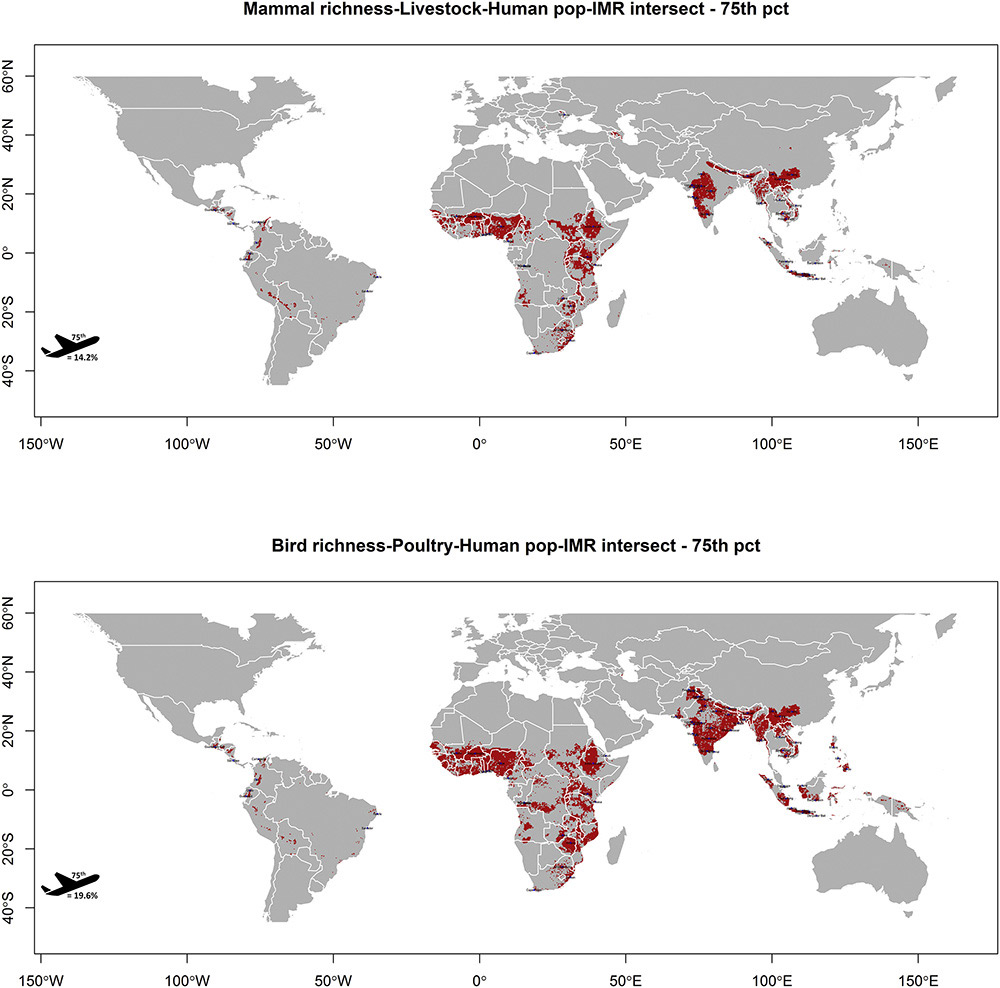孟買,雅加達。馬尼拉。
科學家們表示,上述大都市都將面臨一項全球性的風險:它們可能是下一波疫情的溫床。
一個由悉尼大學(University of Sydney)的科學家領導、國際研究人員組成的團隊用圖繪的方式,標注出了一些特別值得關注的城市——它們可能孕育著下一波從動物傳播到人類、再在全世界爆發的病毒所需的最成熟的條件。
研究人員跟蹤到的風險來自三個因素:首先是確定在哪些城市中,繁忙的都市生活與家養動物以及豐富多樣的野生生物之間可能會產生交集。這種在人類,馴養動物和野生生物之間的接觸通常是由于植被遭到砍伐等自然環境的破壞而增加的。
這就增加了那些能夠從動物傳染給人類的疾病爆發的風險——例如某些病毒可以從哺乳動物或鳥類向人類傳播。正如《財富》雜志在2020年4月的一篇文章中寫道的那樣,在新冠疫情爆發之前,病毒學家和其他科學家就已經發出警報稱,我們所處的現代世界為這種病毒的爆發創造了理想的條件。

但是要造成全球性的大流行,悉尼大學的研究團隊還探究了另外兩個因素。
第二個因素是跟蹤哪些大城市與世界各地都聯系緊密——不只是通過國際機場和航空路線——從而使病毒可以迅速傳播。第三個因素則是公共醫療基礎設施的不足(這里是根據新生兒死亡率來衡量的),會增加其無法識別并報告正在傳播的病毒的風險。
綜合這些因素來看,研究人員發現,在與全球聯系最緊密的城市中,有20%處于能夠傳播這類疾病的風險中。這些城市中還有14%至20%的醫療基礎設施較差,大部分在南亞和東南亞,還有撒哈拉以南的非洲。風險最高的城市包括孟買、德里、雅加達、新加坡和昆明。

研究人員將風險分為三個等級:黃色、橙色和紅色。紅色表示風險等級最高,黃色表示最低。
考慮到醫療衛生水平,中低收入國家在表示高風險的“紅色”區域中占很高的比例。但是悉尼大學的傳染性流行病學專家、也是該研究的作者之一邁克爾?沃爾什表示,一些高收入城市(研究人員特別提到舊金山和澳大利亞的阿德萊德這兩所城市)也存在一定風險,位于黃色區域。沃爾什說,這是因為富裕的城市會對當地的野生動植物產生極端影響。
他說,要應對這些風險,就需要采取一種整體的方法——著眼于野生生物的保護、畜牧業,還有改善人類醫療衛生系統以及對機場的監控,這將是一筆巨大的費用,但卻是必要的。
“鑒于全球那么多地區都面臨著難以承受的巨大風險,還有那么多和我們聯系最緊密的城市也都同時處于高風險之中,這是一件值得引起我們共同關注的事情,并要立即采取措施。”(財富中文網)
編譯:陳聰聰
孟買,雅加達。馬尼拉。
科學家們表示,上述大都市都將面臨一項全球性的風險:它們可能是下一波疫情的溫床。
一個由悉尼大學(University of Sydney)的科學家領導、國際研究人員組成的團隊用圖繪的方式,標注出了一些特別值得關注的城市——它們可能孕育著下一波從動物傳播到人類、再在全世界爆發的病毒所需的最成熟的條件。
研究人員跟蹤到的風險來自三個因素:首先是確定在哪些城市中,繁忙的都市生活與家養動物以及豐富多樣的野生生物之間可能會產生交集。這種在人類,馴養動物和野生生物之間的接觸通常是由于植被遭到砍伐等自然環境的破壞而增加的。
這就增加了那些能夠從動物傳染給人類的疾病爆發的風險——例如某些病毒可以從哺乳動物或鳥類向人類傳播。正如《財富》雜志在2020年4月的一篇文章中寫道的那樣,在新冠疫情爆發之前,病毒學家和其他科學家就已經發出警報稱,我們所處的現代世界為這種病毒的爆發創造了理想的條件。
但是要造成全球性的大流行,悉尼大學的研究團隊還探究了另外兩個因素。
第二個因素是跟蹤哪些大城市與世界各地都聯系緊密——不只是通過國際機場和航空路線——從而使病毒可以迅速傳播。第三個因素則是公共醫療基礎設施的不足(這里是根據新生兒死亡率來衡量的),會增加其無法識別并報告正在傳播的病毒的風險。
綜合這些因素來看,研究人員發現,在與全球聯系最緊密的城市中,有20%處于能夠傳播這類疾病的風險中。這些城市中還有14%至20%的醫療基礎設施較差,大部分在南亞和東南亞,還有撒哈拉以南的非洲。風險最高的城市包括孟買、德里、雅加達、新加坡和昆明。
研究人員將風險分為三個等級:黃色、橙色和紅色。紅色表示風險等級最高,黃色表示最低。
考慮到醫療衛生水平,中低收入國家在表示高風險的“紅色”區域中占很高的比例。但是悉尼大學的傳染性流行病學專家、也是該研究的作者之一邁克爾?沃爾什表示,一些高收入城市(研究人員特別提到舊金山和澳大利亞的阿德萊德這兩所城市)也存在一定風險,位于黃色區域。沃爾什說,這是因為富裕的城市會對當地的野生動植物產生極端影響。
他說,要應對這些風險,就需要采取一種整體的方法——著眼于野生生物的保護、畜牧業,還有改善人類醫療衛生系統以及對機場的監控,這將是一筆巨大的費用,但卻是必要的。
“鑒于全球那么多地區都面臨著難以承受的巨大風險,還有那么多和我們聯系最緊密的城市也都同時處于高風險之中,這是一件值得引起我們共同關注的事情,并要立即采取措施。”(財富中文網)
編譯:陳聰聰
Mumbai. Jakarta. Manila.
All of these mega-metropolises share a global risk, scientists say: they could be breeding grounds for the next pandemic.
A group of international researchers, led by scientists at the University of Sydney, have mapped out the cities that offer the ripest conditions for the incubation of viruses that could jump from animals to humans—and then spread around the world.
The researchers tracked the risks based on three factors: the first was identifying cities where intense urban life collides with both domesticated animals and rich biodiversity, raising interactions between humans, farmed animals, and wildlife, often due to disruption like deforestation.
This increases the risks of zoonotic disease outbreaks in which, for example, a virus makes the jump from a mammal or bird species to humans. Well before the arrival of COVID-19, virologists and other scientists have been sounding the alarm that our modern world creates ideal conditions for just such an outbreak, as Fortune wrote in April 2020.
But to create a global pandemic, the Sydney researchers researched an additional two factors.
The second is tracking which of those super cities are globally connected—not just through international airports and aviation routes—allowing the virus to be spread quickly. The third factor is an insufficient public healthcare infrastructure (measured, in this case, by rates of infant mortality), which increased the risk that a virus in circulation won't be identified and reported straight away.
Combining those factors, the researchers found that 20% of the world's most-connected cities are at risk of such disease spreads. Another 14-20% of those cities have poor health infrastructure, with the majority in South and Southeast Asia, and Sub-Saharan Africa. The cities with the highest risks including Mumbai, Delhi, Jakarta, Singapore, and Kunming, in China.
The researchers broke the risks down into three levels: a yellow, orange and red rating system with red the highest risk, yellow the lowest.
Low- and -middle income countries are highly represented in "red" due to the healthcare risks. But some high-income cities—the researchers cite San Francisco, and Adelaide, Australia as two—can be found in the yellow tier, said Michael Walsh, an infectious disease epidemiologist at the University of Sydney and one of the authors of the study, in a release. That's because of the extreme impact more affluent cities can have on local wildlife, Walsh said.
Addressing these risks would require a holistic approach, he said, one that looks at wildlife conservation and animal husbandry alongside human healthcare systems and monitoring and surveillance at airports—a huge cost, but a necessary one.
"Given the overwhelming risk absorbed by so many of the world's communities and the concurrent high-risk exposure of so many of our most connected cities, this is something that requires our collective prompt attention."






